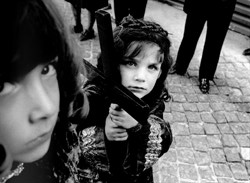© of the photographs, Ricard Terré
© of the texts, the authors and translators
© of the page, Carlos Terré

Some authors remain calm when they use the word "report" in order to group under this denomination the work of those photographers who get images from the reality which flows by and makes happenings. The images constitute a river of parallel course with history, of which they are its witnesses.
From this point of view, photography, as far as it follows lifetimes, poorly substitutes life; it can't be held as art.
But, can we really say that in the case of Ricard Terré, just like in a lot of other photographers', we find ourselves in front of report photography? Is it rigorous to place this photographic work within a group that suggests in first place information and current events? The purpose of the report's information is to fulfill the need of news; it deals with an objective document. Its effect over the public is clear: it broadens their vision horizons, it makes them connoisseurs, it gives them reach, security - there's nothing unknown for them - and, in consequence, power.
The work that's in front of us is, on the other hand, subjective: it opens a great abyss of interpretations between us and reality. It doesn't inform: it troubles. It doesn't cover an event, it doesn't illustrate an event; it proposes an ambivalence of the being, subtle, contradictory. The newness that this images could show us, all their reality ,is faded under the effect of a subjective moment, personal and poetical. This is how it is registered in our minds as something eternal (lacking time), that belongs to humanity (overcoming the anecdote). Maybe this is why Ricard Terré, when he sets up his photographs for the exhibition, doesn't have in mind the "chronological" aspect to which we are used to in anthological exhibitions. The author doesn't see time going by between his photographs. We can say that there's no time in his photographs.
(Anyway, leaving a little behind this temptation of non-temporality, - to which good photography tends to go - it's interesting to notice the space of time that goes from one photograph to another, reading their dates in order to appreciate the evolution of a style of strong coherence in his respect towards a truly photograph conception, but flexible in adapting the new resources.).
His way of working is closer to intuitive creation than to a job that is done with a repetitive method. His working material are not the events that run through the sense of existence, but the emotional of the things and the beauty they exude in their stillness and everlasting nature. As poets, he uses images not as a representation of reality, but as the simile, the metaphor of another interior world. Not an exclusive interior world of the photographer - and there is where we find his strength- but in harmony with sense, with the soul that brightens up the reality that's around it.
His working process is about being suprised by images (thematic concern), then choose them attending to the "roundness" of their shape (aesthetic concern), and establish between them subtle relations that call forth the strength of their original meaning (dramatic concern).
So we find ourselves in front of a creation that's closer to poetry than to a chronicle, in which an image isn't better than a thousand words,-like in the popular saying often used in photography- but it has a thousand meanings. Each photograph is a proposal that chained to one another makes a structured poem, that settles a time of its own that doesn't have anything to do with the time that made them. In Ricard Terré's work there's no will to tell a story, no will to make a magnificent happening. His work is simply lyric, each of his photographs is the "addition of being sensitive in just one instant".
His shots isolate a precise moment of the human being and break the chains to which they are attached to anecdote. His photographs can't be held as chapters of a report.
Despite of the subjects chosen that are always spectacular-at least from the existential point of view: death, childhood, disguise, etc.- the subtlety of their presentation even gives them a banal nature. He often uses paraphrases, he escapes from the crude and open truth, he looks for the ambiguous. In simultaneous feelings he gets drama, but this is never openly shown, but through an ambiguous image, hardly ambiguous.
According to his words -I've heard him saying it so many times!- the strength of photography is in being able to show the others an event that's not coming back again, that it was given to the photographer in the conjunction of a certain time and space. What we appreciate the most when Ricard Terré shows his images, is his point of view since he was aware of that poetical instant through his own , and he transmits it to us with a personal way. There's always a sense of humor in that point of view that with a personal way always reveals a warm tenderness in treating the subjects despite how tough they may look. The daring he's got when he deals with some "delicate" subjects from a humorous point of view, doesn't show as much courage but ingenuousness. This is probably the characteristic that mostly brings him back to the period in which he started doing photography, and in which the language of picaresque was the safest way to communicate ideas.
Let's place ourselves in front of one of those images and let feelings grow in disorder while time around us proves that time doesn't pass by them.
Laura Terré
Barcelona, june de 1992